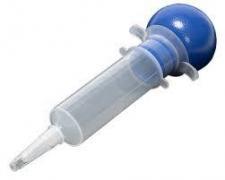Modalities Utilized in Wound Healing- Wound Irrigation
Although not a true modality, wound irrigation is a common treatment that serves multiple purposes. Let’s look at some of the ways in which wound irrigation can be used to enhance wound healing.
Functions of Wound Irrigation
Wound irrigation serves many important functions:
- removes cellular debris that is loosely adherent
- remove surface bacteria
- removes wound exudate
- removes topical agents and dressing residue
Indications/Precautions
Wound irrigation may be performed on all types of wounds, with the exception of wounds that are actively bleeding.
How to Perform
Wounds should be irrigated the first time they are visualized and with every dressing change. Normal saline is the most common irrigant used; however, tap water may be used in place of normal saline if clean water is available. In fact, some research has shown that tap water results in faster wound healing and is more cost-effective than irrigation with normal saline. Whichever is used, wound irrigation must always be performed with minimal force. Pouring normal saline or tap water over the wound or using a syringe will not provide enough pressure to remove surface pathogens or to prevent the development of infection. However, using too much force can traumatize the wound bed and can actually propel foreign debris and pathogens beyond the wound surface and into the deeper tissues.
It is recommended that wounds be irrigated using pressures between 4 and 15 psi. This is the equivalent of using a WaterPik at its lowest setting (approximately 6 psi). Wound care manufacturers have developed pressurized saline canisters which also provide safe irrigation pressures. For the prevention of infection, recent recommendations are to use pressures between 10 and 15 psi. Irrigation can be performed alone, but is often performed in conjunction with other modalities such as whirlpool, ultrasound, and/or electrical stimulation.
Patient Considerations
Prior to the procedure, explain the purpose of irrigation to the patient and what they can expect. Position the patient comfortably to allow easy access to the wound. Remove all dressings and drape the patient for modesty. It is best to use towels or other absorbent material to absorb any runoff. Once the wound has been irrigated, dry any areas of intact skin gently with a towel. Open areas can be left open to the air or patted gently with a sterile gauze 4 x 4 to absorb any excess fluid. Next, perform any debridement necessary or other modalities prior to applying a new dressing. Remember to protect yourself from splash injury using appropriate barrier devices.
Advantages/Disadvantages
Wound irrigation is easy to perform, quick, cost-effective and very efficient at removing surface pathogens. Irrigation can be performed in virtually any patient setting: home care, outpatient or inpatient. Some patients can be taught to perform their own wound irrigation prior to changing their own dressing. A disadvantage is that fluid runoff may soil the patient’s clothing or bed linens if inadequate absorbent material is not used. This may lead clinicians to use less solution than called for, which may render the treatment less effective.
This is the first in a series of articles that well lead you through most of the electrotherapeutic, physical and mechanical modalities used in wound care today. Visit Wound Educators weekly to follow our series.
If you are interested in wound care management, visit Wound Educators to get the latest information in wound care. Interested in becoming at certified wound care practitioner? Wound educators has a course designed especially for you. Contact us if you have questions or require further information.
Sources:
Weiss, E., Oldham, G., Lin, M., Foster, T. & Quinn, J. (2013). Water is a safe and effective alternative to sterile normal saline for wound irrigation prior to suturing: a prospective, double-blind, randomised, controlled clinical trial. BMJ Open 2013.
Perry, A., Potter, P. & Ostendorf, W. (2013). Clinical Nursing Skills and Techniques. 8th edition. Elsevier Health Sciences.

